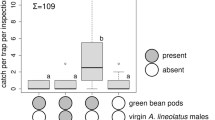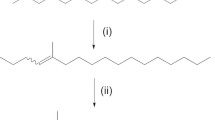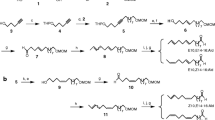Abstract
Xenos peckii is a strepsipteran parasitoid of the common North American paper wasp, Polistes fuscatus. Mate-seeking X. peckii males respond to a long-range sex pheromone emitted by the female, which remains permanently embedded within the abdomen of a mobile host wasp. During peak pheromone signalling, we excised the female from her host, severed the cephalothorax containing the pheromone gland, extracted it in hexane, and analyzed aliquots of combined extracts by coupled gas chromatographic-electroantennographic detection (GC-EAD). These analyses revealed a candidate pheromone component (CPC) that consistently elicited strong responses from male antennae. We identified the CPC as (7E,11E)-3,5,9,11-tetramethyltridecadienal based on its retention indices (RI) on three GC-columns, RI inter-column differentials, mass and NMR spectra, and synthesis of an authentic standard that matched the GC-retention and spectrometric characteristics of the CPC. For a field experiment, we prepared (7E,11E)-3,5,9R,11-tetramethyltridecadienal and (7E,11E)-3,5,9S,11-tetramethyltridecadienal. Xenos peckii males were caught in traps baited with either compound singly or a 1:1 mixture of the two but not in unbaited control traps. The sex pheromone of X. peckii resembles that reported for the strepsipterans Stylops mellittae and S. muelleri, (R,R,R)-3,5,9-trimethyldodecanal, suggesting a common biosynthetic pathway across taxonomic genera.






Similar content being viewed by others
References
Amorelli B, Arruda ME, Belko RP, Cai T, Closson AP, Giffin NL, Mertz GJ, Monteleone MG (2015) Novel organoleptic compounds. U.S. Pat. Appl. Publ. US 20150057207
Appel R (1975) Tertiary phosphane/tetrachloromethane, a versatile reagent for chlorination, dehydration, and P—N linkage. Angew Chem Int Ed Engl 14:801–811
Arn H, Städler E, Rausher S (1975) The electroantennographic detector – a selective and sensitive tool in the gas chromatographic analysis of insect pheromones. Z Naturforsch 30c:722–725
Borden JH, Chong L, McLean JA, Slessor KN, Mori K (1976) Gnathotrichus sulcatus: synergistic response to enantiomers of the aggregation pheromone sulcatol. Science 192:894–896
Borden JH, Handley JR, McLean JA, Silverstein RM, Chong L, Slessor KN, Johnston BD, Shuler HR (1980) Enantiomer-based specificity in pheromone communication by two sympatric Gnathotrichus species (Coleoptera: Scolytidae). J Chem Ecol 6:445–456
Boussau B, Walton Z, Delgado JA, Collantes F, Beani L, Stewart IJ, Cameron SA, Whitfield JB, Johnston S, Holland PWH, Bachtrog D, Kathirithamby J, Huelsenbeck JP (2014) Strepsiptera, phylogeomics and the long branch attraction problem. PloS ONE 9(10):e107709
Cvačka J, Jiroš P, Kalinová B, Straka J, Černá K, Šebesta P, Tomčala A, Vašíčková K, Jahn U, Šobotník J (2012) Stylopsal: the first identified female-produced sex pheromone of Strepsiptera. J Chem Ecol 38:1483–1491
Dallai R, Lupetti P, Guisti F, Mercati D, Paccagnini E, Turillazzi S, Beani L, Kathirithamby J (2004) Fine structure of the Nassonow’s gland in the neotenic endoparasitic female Xenos vesparum (Rossi) (Strepsiptera, Insecta). Tissue Cell 36:211–220
Evans DA, Ennis MD, Mathre DJ (1982) Asymmetric alkylation reactions of chiral imide enolates. A practical approach to the enantioselective synthesis of α-substituted carboxylic acid derivatives. J Am Chem Soc 104:1737–1739
Fotiadou AD, Zografos AL (2011) Accessing the structural diversity of pyridine alkaloids: concise total synthesis of rac-citridone A. Org Lett 13:4592–4595
Francke W, Dettner K (2005) Chemical signalling in beetles. In: Schulz S (ed) The chemistry of pheromones and other semiochemicals II: topics in current chemistry 240. Springer, Berlin, Heidelberg, New York, pp 85–166
Gries G, Gries R, Schaefer PW, Gotoh T, Higashiura Y (1999) Sex pheromone components of pink gypsy moth, Lymantria mathura. Naturwissenschaften 86:235–238
Gries R, Khashkin G, Gries G, Bennett RG, King S, Morewood P, Slessor KN, Morewood WD (2002) (Z,Z)-4,7-Tridecadien-(S)-2-yl acetate: sex pheromone of Douglas-fir cone gall midge contarinia oregonensis. J Chem Ecol 28:2283–2297
Gries R, Khaskin G, Khaskin E, Foltz JL, Schaefer PW, Gries G (2003) Enantiomers of (Z,Z)-6,9-heneicosadien-11-ol: sex pheromone components of Orgyia detrita. J Chem Ecol 29:2201–2212
Gries R, Khashkin G, Schaefer PW, Hahn R, Gotoh T, Gries G (2005) (7R,8S)-cis-7,8-Epoxy-2-methyloctadec-17-ene: a novel trace component from the sex pheromone gland of gypsy moth, Lymentria dispar. J Chem Ecol 31:49–62
Hanessian S, Mascitti V, Giroux S (2004) Total synthesis of the cytotoxic cyclodepsipeptide (−)-doliculide: the “ester” effect in acyclic 1,3-induction of deoxypropionates. Proc Natl Acad Sci U S A 101:11996–12001
Hrabar M, Danci A, McCann S, Schaefer P, Gries G (2014) New findings on life history traits of Xenos peckii (Strepsiptera, Xenidae). Can Entomol 146:512–527
Kathirithamby J (2009) Host-parasitoid associations in strepsiptera. Annu Rev Entomol 54:227–249
Krombein KV, Hurd PD Jr (1979) Catalog of hymenoptera in America North of Mexico. Volume 2 apocrita (Aculeata). Smithsonian Institution Press, Washington
Lagoutte R, Šebesta P, Jiroš P, Kalinová B, Jirošová A, Straka J, Černá K, Šobotník J, Cvačka J, Jahn U (2013) Total synthesis, proof of absolute configuration, and biosynthetic origin of stylopsal, the first isolated sex pheromone of Strepsiptera. Chem Eur J 19:8515–8524
Millar JG, Giblin M, Barton D, Morrison A, Underhill EW (1990) Synthesis and field testing of enantiomers of 6Z,9Z-cis-epoxydienes as sex attractants for geometrid moths. J Chem Ecol 16:2317–2339
Millar JG, Giblin M, Barton D, Underhill EW (1991) Chiral lepidopteran sex attractants: blends of optically active C20 and C21 diene epoxides as sex attractants for geometrid and noctuid moths (Lepidoptera). Environ Entomol 20:450–457
Payne TL, Richerson JV, Dickens JC, West JR, Mori K, Berisford CW, Hedden RL, Vité JP, Blum MS (1982) Southern pine beetle: olfactory receptor and behaviour discrimination of enantiomers of the attractant pheromone frontalin. J Chem Ecol 8:873–881
Rodstein J, Millar JG, Barbour JD, McElfresh JS, Wright IM, Barbour KS, Ray AM, Hanks LM (2011) Determination of the relative and absolute configurations of the female-produced sex pheromone of the cerambycid beetle Prionus californicus. J Chem Ecol 37:114–124
Schaefer PW, Jiang M, Gries R, Gries G, Wu J (2013) Attraction of male Lymantria schaeferi Schintlmeister (Lepidoptera: Erebidae: Lymantriinae) to traps baited with (+)-xylinalure in Jiangxi Province, China. Life Excitement Biol 1:95–99
Schmidt Y, Lehr K, Colas L, Breit B (2012) Assignment of relative configuration of desoxypropionates by 1H NMR spectroscopy: method development, proof of principle by asymmetric total synthesis of xylarinic acid A and applications. Chem Eur J 18:7071–7081
Schraeder SH (1924) Reproduction in Achroschismus wheeleri Pierce. J Morphol Physiol 39:157–205
Staddon BW, Everton IJ (1980) Haemolymph of milkweed bug Oncopeltus fasciatus (Heteroptera: Lygaeidae): inorganic constituents and amino acids. Comp Biochem Physiol 65A:371–374
Tolasch T, Kehl S, Dötterl S (2010) Sex pheromone of a twisted-wing parasite. Lecture on the 26th Annual Meeting of the ISCE, August 2nd 2010, Tours, France
Tolasch T, Kehl S, Dötterl S (2012) First sex pheromone of the order strepsiptera: (3R,5R,9R)-3,5,9-trimethyldodecanal in Stylops melittae Kirby, 1802. J Chem Ecol 38:1493–1503
Van den Dool H, Kratz PD (1963) A generalization of the retention index system including linear temperature-programmed gas–liquid partition chromatography. J Chromatogr 2:463–471
Wood DL (1982) The role of pheromones, kairomones, and allomones in the host selection and colonization behaviour of bark beetles. Annu Rev Entomol 27:411–446
Acknowledgments
We thank Pilar Cepeda for assistance with rearing wax moths to feed wasps; Jim Henshaw, Dan Long, Parker Nelson, Christine Payne, Ralph Payne, Dianne Pratt, and Dan Ring for permission to collect wasp nests from their properties or to hang pheromone-baited traps; Stephen DeMuth for graphical illustrations; Laurence Packer for help in locating stylopized hymenoptera populations; Caesar Inducil and Anna Löppmann for help with field collections; Rodney Bushway, Francis Drummond, Eleanor Groden, and Tamara Levitsky (University of Maine) for providing laboratory space and logistical support, and two anonymous reviewers for constructive comments. This research was supported by a Natural Sciences and Engineering Research Council of Canada (NSERC) – Discovery Grant to GG, and by an NSERC Discovery Grant and a MSFHR Career Investigator Award to RB.
Author information
Authors and Affiliations
Corresponding author
Electronic supplementary material
Below is the link to the electronic supplementary material.
Xenos peckii male locating and mating with a female embedded in a Polistes fuscatus host wasp. Note repeated copulation attempts. (MP4 14256 kb)
ESM 2
Details of all synthetic procedures (DOCX 25 kb)
Rights and permissions
About this article
Cite this article
Hrabar, M., Zhai, H., Gries, R. et al. (7E,11E)-3,5,9,11-Tetramethyltridecadienal: Sex Pheromone of the Strepsipteran Xenos peckii . J Chem Ecol 41, 732–739 (2015). https://doi.org/10.1007/s10886-015-0613-7
Received:
Revised:
Accepted:
Published:
Issue Date:
DOI: https://doi.org/10.1007/s10886-015-0613-7




